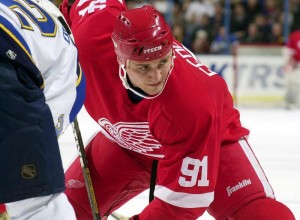
Since Scotty Bowman took over as head coach of the Detroit Red Wings in 1993, the puck possession game has been the Red Wings’ clear identity. Even when Dave Lewis and Mike Babcock took the helm, the European-influenced, possession style of play remained. Steve Yzerman, Nicklas Lidstrom, Sergei Fedorov, Pavel Datsyuk, and Henrik Zetterberg, among others, helped establish Detroit’s game as the template that the rest of the league would soon follow.
Now, the former three are retired and in the NHL Hall of Fame. The latter two—Datsyuk and Zetterberg—are nearing the ends of their respective careers. And with these changes of the guard, the team’s identity has changed as well. The Detroit Red Wings are no longer a puck possession team. It may be their stated style of play, but far from what is delivered and seen on the ice.
This is not intended to be a jaded condemnation of an underperforming team, but merely a fair evaluation of the Red Wings’ average, game-to-game play when in possession of the puck.
As much is it pains to say that the Red Wings are no longer the model of success for the NHL, their patented puck possession game is a thing of the past. And its departure from the Red Wings’ team strategy is evidenced in all facets of their play—starting in the defensive zone after a dump in and ending in the offensive zone.
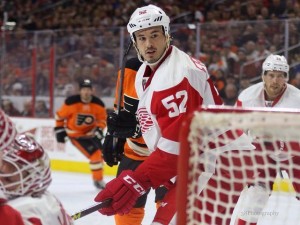
Collecting the Puck
Throughout their years of dominance, the Red Wings made a living off of their neutral and defensive zone transition game. When an opponent would turn over the puck—whether by accident or by a dump in—the Red Wings were quick to turn the puck back up ice in an orderly and dangerous offensive manner.
This season has been quite different with regard to the defense facilitating offensive play when gaining control of the puck. Transitions are slowed, usually with the idea of building up collective momentum by making a few cross-ice passes while the forwards gathered speed in the neutral zone. And collecting the puck after a dump in, hitting a forward with a pass, and exiting the defensive zone has become quite an ordeal. Winging It In Motown’s Prashanth Iyer recently detailed defensive zone breakouts and what exactly the Red Wings’ defensemen are doing to bungle the collection and up-ice transition of the puck.
Instead of looking to create separation and space with a quick move or a quick pass, Detroit’s defensemen are more apt to slow up as they approach the puck and look to protect the puck. This allows the forecheck to close in on the defenseman and create a board battle.
Iyer goes on to explain that the defenders are not the entirety of the problem. They have to pass to someone.
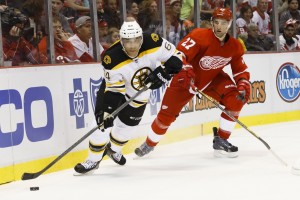
After the puck is collected by a defenseman and head-manned to a winger on the boards, the Red Wings often run into another problem. When in the defensive zone and facing a forecheck, Red Wings’ defensemen have a few options: 1) go high off the glass and get the puck out, 2) hit the center with a pass in front of the net, 3) pass to the other defenseman, and 4) pass to wing on the half-wall. If there is significant pressure, going high off the glass is usually the default choice. But when given enough time to make a play, the typical choice is to throw it up the board to the wing waiting on the half-wall.
The issue with this choice is that the puck is turned over an alarming amount of times along the boards before crossing the blue line. In this situation, the opponent’s defender at that point position typically pinches on the wing and either bumps them off the puck, blocks an exit attempt, intercepts an outlet pass, or receives the puck after it hops over the stick of the wing who heard footsteps coming. At such a critical part of breaking the puck out and generating odd-man rushes, the Red Wings’ basic exit strategy and alarmingly high tendency to lose the puck without much pressure handcuffs their chances to create offense.
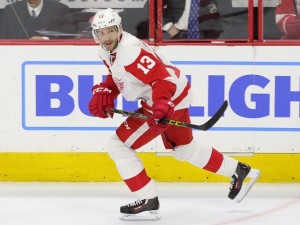
Neutral Zone Possession
After successfully exiting the defensive zone, what neutral zone bad habits have the Red Wings developed over the course of the 2015-16 season? Apart from erratic passes stemming from too little time to evaluate the play, the Red Wings’ slow foot speed and lack of support further curtail could-have-been offensive chances.
When skating the puck through center ice, the Red Wings’ rush has two usual barriers to success: 1) slow foot speed by the puck carrier causes a turnover or 2) a player with speed skates through, enters the offensive zone, and has no one to pass to. An Achilles’ Heel of the Red Wings’ breakout this season has been their passing just prior to their opponent’s blue line. All too often, the pass is poorly made, causing the receiving player to slow momentum when they need it most. Players stopping or slowing to barely any forward movement has unfortunately become commonplace with the Red Wings’ neutral zone scheme. And the only real play the receiving player has is to dump the puck in.

Additionally, when a player of Brad Richards, Niklas Kronwall, or Henrik Zetterberg’s nature facilitates the play up ice, the opponents can usually back off and then apply direct pressure to the puck carrier right at the blue line. This causes either a lateral pass or a dump in.
So in both cases of faulty neutral zone possession, dumping the puck in is often the direct result. So what’s wrong with dump and chase?
Apart from carrying the puck into the zone typically resulting in more shots and goals, dumping the puck in—in the Red Wings’ case—all too often results in the opponent collecting the puck and breaking out the other way. The problem for the Red Wings is that the chasers for the dump and chase are slowing their momentum at the blue line. The puck carrier is slowing up, so the other forwards need to slow up or else they’ll likely be offsides. So when the puck is dumped in, the chasers don’t have any speed to swoop in and recover the puck or pressure the defensemen into a turnover.
And again, this is not always the case. The Red Wings also carry the puck into the zone when there is less defensive pressure and start an offensive zone possession.
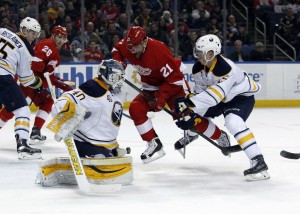
Getting the Puck on Net
Once in the offensive zone, the Red Wings usually opt to maintain a perimeter possession—passing the puck around along the boards and blue line. While this is a trait of a puck possession team—making low-risk passes and waiting for opportunity to open up—the Red Wings have one main issue plaguing their chances: getting knocked off the puck.
A problem in the defensive zone is also a problem for the Red Wings’ forwards in the offensive zone. Once pressured, the Red Wings simply turn the puck over too much. Any momentum gained in the offensive zone by a couple of crisp, completed passes can be smothered by a defender playing the body. This is especially true when working the puck down low. As a staple of the puck possession style, cycling the puck around the goal line allows other players to get open with the defense’s back turned. When possessing the puck down low, the Red Wings are easily stymied by strong pressure. When the defense backs off, they excel passing the puck around. But opponents have found that playing the body down low creates turnovers when facing the Red Wings.
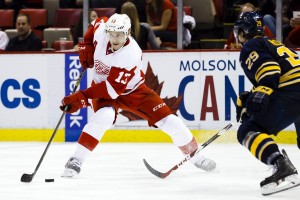
Another issue the Red Wings face in the offensive zone is their problem getting pucks to the net. A common phrase of Red Wings’ play-by-play announcer Ken Daniels this season has been, “Shot! …and it’s blocked.” Getting pucks to the net from the outside has been a disaster this season. Because the Red Wings do not have the physical players to work the slot and fend off opponents, they have to opt for outside shots through screens. And with equipment becoming nearly bulletproof, defenders have no problem stepping in front of shots and blocking them.
Again, when the Red Wings have the space to enter high-danger scoring areas, they seize the opportunity and get shots off. They’re ranked in the middle of the pack (15th) for unblocked shot attempts this season at 50.35%. Their ranking shows that, while they do have quite a few shots blocked, they do get a fair amount through. Whether those shots hit the net or not is a different story.
Last Word
Arguably, the Red Wings are no longer a puck possession team. They may play that style, but it is not executed well enough to succeed, as evidenced by their record. But this is not to say that they can’t return to their bread and butter. They’ve allowed the fewest shot attempts in the NHL, but are ranked 22nd when counting shot attempts for. Stay tuned for the next blog post that will discuss how the Red Wings can return to dominance using their patented style of play.
Recent Posts:
Zetterberg’s Ice Time Should Be Decreased
The Greatest Detroit Red Wings Team Not to Win the Stanley Cup